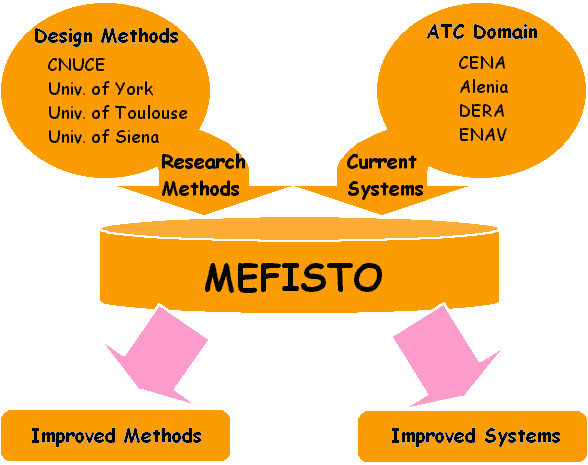|
|
|
|
|
|
![]() To design a method which allows designers to develop ATC user interface
specifications and related software implementations which satisfy usability
and safety requirements. This would allow software designers and developers
to reduce the costs of their work as it is easier and cheaper to correct
errors and bad design choices in the first phases of the design and
development cycle.
To design a method which allows designers to develop ATC user interface
specifications and related software implementations which satisfy usability
and safety requirements. This would allow software designers and developers
to reduce the costs of their work as it is easier and cheaper to correct
errors and bad design choices in the first phases of the design and
development cycle.
![]() To develop a set of automatic tools supporting the method and allowing
designers to address large size, industrially relevant, case studies. Some
tools are developed from scratch, others by modifying existing tools.
Different tools will address different phases: formal specification
verification, software prototyping from specifications, usability
evaluation. Most of the phases of the global method developed will be
semi-automatic so as to allow designers to concentrate on semantically
relevant aspects and will have automatic support for repetitive processing.
To develop a set of automatic tools supporting the method and allowing
designers to address large size, industrially relevant, case studies. Some
tools are developed from scratch, others by modifying existing tools.
Different tools will address different phases: formal specification
verification, software prototyping from specifications, usability
evaluation. Most of the phases of the global method developed will be
semi-automatic so as to allow designers to concentrate on semantically
relevant aspects and will have automatic support for repetitive processing.
![]() To implement ATC user interfaces prototypes which are validated against
usability and safety requirements by formal specification and empirical
testing. They will provide concrete examples for end users (air traffic
controllers) indicating how new methods and technologies can optimise their
work in front of the growing complexity caused by the increase of air
traffic.
To implement ATC user interfaces prototypes which are validated against
usability and safety requirements by formal specification and empirical
testing. They will provide concrete examples for end users (air traffic
controllers) indicating how new methods and technologies can optimise their
work in front of the growing complexity caused by the increase of air
traffic.
![]() Develop a method, and related tools, which allow designers to apply
formal methods in order to perform usability and safety evaluation over the
formal specification of the system. This evaluation is mainly carried out
by using model checking techniques. The formal approach can be used to
provide some performance evaluation in a system model which is obtained in
a task-driven way. We aim at eliciting and verifying a set of criteria to
establish, during the design process, whether a system will reach a
satisfactory quality level for the end user.
Develop a method, and related tools, which allow designers to apply
formal methods in order to perform usability and safety evaluation over the
formal specification of the system. This evaluation is mainly carried out
by using model checking techniques. The formal approach can be used to
provide some performance evaluation in a system model which is obtained in
a task-driven way. We aim at eliciting and verifying a set of criteria to
establish, during the design process, whether a system will reach a
satisfactory quality level for the end user.
![]() Define and implement an approach which takes formal specifications
validated against usability and safety requirements and produces a related
software prototype in a multimodal environment. The software implementation
of the multimodal user interface must fulfil the requirements verified over
the formal specification.
Define and implement an approach which takes formal specifications
validated against usability and safety requirements and produces a related
software prototype in a multimodal environment. The software implementation
of the multimodal user interface must fulfil the requirements verified over
the formal specification.
![]() Develop a method for usability evaluation of ATC user interfaces and
apply it to the prototypes developed to improve their overall quality. The
method takes into account empirical evaluations and the models (user, task,
architectural models) used to drive software design and development. It is
tool-supported to manage the large volume of data which can be collected
while the users are testing the prototypes.
Develop a method for usability evaluation of ATC user interfaces and
apply it to the prototypes developed to improve their overall quality. The
method takes into account empirical evaluations and the models (user, task,
architectural models) used to drive software design and development. It is
tool-supported to manage the large volume of data which can be collected
while the users are testing the prototypes.
